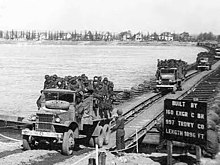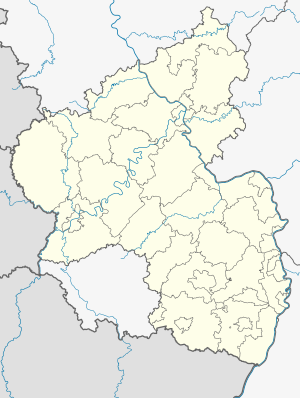Alexander M. Patch Bridge
Coordinates: 50 ° 0 ′ 40 ″ N , 8 ° 16 ′ 22 ″ E
| Alexander M. Patch Bridge | ||
|---|---|---|
| Temporary bridge between Mainz and Mainz-Kastel | ||
| use | Road bridge | |
| Convicted | Reichsstrasse 40, later Bundesstrasse 40 , connection Mainz - Mainz-Kastel |
|
| Crossing of | Rhine | |
| place | Mainz ( Germany ) | |
| construction | Steel / wood girder bridge with steel piers | |
| overall length | 610 m | |
| Number of openings | 27 | |
| Longest span | ~ 50 m above the fairway | |
| Pillar spacing | ~ 19.90 m | |
| Load capacity | 70 t | |
| start of building | 1945 | |
| completion | January 18, 1946 | |
| Status | Dismantled | |
| planner | 333rd Engineer Special Service Regiment add. construction work | |
| closure | 1963 | |
| location | ||
|
|
||
| Above sea level | 84 m | |
The Alexander-M.-Patch-Brücke was a Rhine bridge in Mainz named after the American general Alexander M. Patch .
history

There was a permanent bridge over the Rhine in Mainz as early as Roman times, but it was probably destroyed in the 5th century. Since the 17th century there was a continuous bridge connection to the Mainz-Kastel bridgehead on the right bank of the Rhine . First by the ship bridge completed in 1661 , later by the fixed road bridge built in 1882–1885 . This was widened from 1931 to 1934. But on March 17, 1945, shortly before the American troops reached the city towards the end of the Second World War , the bridge, as well as the other Rhine bridges in Mainz, was blown up by the retreating German troops.
After taking the city, the Americans built a makeshift pontoon bridge within ten hours to be able to cross over to the right bank of the Rhine. This bridge existed from March 26, 1945 to April 14, 1945 and was used for the advance of the US Army. This pontoon bridge was about 500 m downstream of the blown road bridge in the extension of Kaiserstraße .
construction
After the Second World War there was a need for a permanent bridge over the Rhine in Mainz. As the road bridge that had been blown up could not be restored in time, a temporary bridge was built in the area of the former pontoon bridge from autumn 1945 . The 333rd Engineer Special Service Regiment was responsible for the design and construction .
The foundation of the makeshift bridge and its 27 pillars consisted of tubular steel , after which a bridge superstructure was erected in a construction made of sectional steel and multilayered wooden beams and wooden decking. Above the narrow fairway in the bridge area, the middle section of the bridge consisted of two steel framework superstructures, each weighing 280 tons . The bridge was designed for a load of 40 tons each for two-way traffic or 70 tons for one-way traffic. The construction time was three months. In the presence of representatives of the American and French occupation forces, the bridge was inaugurated on January 18, 1946.
It remained in operation until the road bridge was restored on May 15, 1950 and was put into operation under the name Theodor-Heuss-Brücke. As a temporary bridge, the Alexander-M.-Patch-Brücke was only partially safe. At the end of the 1950s it was only used at certain times of the day for public transport with limited traffic. After the new construction of the Schiersteiner Bridge and the Weisenauer Bridge with their joint inauguration on December 12, 1962 by the then Federal Transport Minister Hans-Christoph Seebohm , the temporary bridge was finally closed to traffic. It was also decided to dismantle the Alexander-M.-Patch-Bridge in order to remove the narrowing of the navigation channel in height and width by the old temporary bridge. The dismantling had to wait until after the last ice drift in the Rhine from December 27, 1962 to March 7, 1963, until dismantling began in spring 1963. The height restriction above the fairway was eliminated due to the dismantling of the second steel framework superstructure on March 22, 1963, which was lifted with a floating crane from the south side of the bridge and brought to the bank of the Rhine.
Planning of the second Rhine bridge
The location of the Alexander-M.-Patch-Brücke was planned in the traffic planning of the city of Mainz even after the reconstruction of the Theodor-Heuss-Brücke for a second bridge in the city area. As early as 1961, the Mainz general planning officer Ernst May complained that the Theodor-Heuss-Brücke was overloaded at peak times. In the city's program plan from 1958, the second Rhine bridge was planned in place of the Alexander-M.-Patch-Bridge as a direct continuation of the Kaiserstraße to the Kasteler Ufer. Kurt Leibbrand's traffic planning provided for a bridge crossing over the Rheinallee in the Kaiserstraße area; the ramp of the new bridge would have been between Rheinallee and Christ Church. The new bridge should have had a superordinate function as the main bypass, the old Theodor-Heuss-Bridge, due to its less favorable location in terms of traffic, only served as a feeder.
However, the second Rhine bridge was not built in the Mainz city center area. With the expansion of the Mainzer Ring , the traffic was distributed more widely through two more road bridges , the Schiersteiner Brücke and the Weisenauer Brücke . In addition, the Theodor Heuss Bridge was extensively renovated and widened from 1992 to 1995.
literature
- E. May, F. Boesler, K. Leibbrand: "Das Neue Mainz"; City administration of Mainz, 1961
Web links
- Museum-castellum.de to the Alexander-M.-Patch-Bridge
- Website about the construction by the 333rd Engineer Special Service Regiment (with pictures)
- View of the AM patch bridge from min: sec 0:03 to 0:04
Individual evidence
- ↑ The pontoon bridge was up in ten hours ( memento from January 7, 2014 in the Internet Archive )
- ↑ according to a filmed contemporary document from 1946: http://www.criticalpast.com/video/65675046675_Joseph-Taggart-McNarney_new-bridges-across-Rhine_for-automobile-traffic_new-railroad
- ↑ a b E. May, F. Boesler, K. Leibbrand: "Das Neue Mainz"; Mainz City Administration, 1961: p. 23
- ^ Opening of two new multi-lane motorway bridges over the Rhine near Mainz and Wiesbaden, December 12, 1962. Contemporary history in Hesse. In: Landesgeschichtliches Informationssystem Hessen (LAGIS).
- ↑ Waterways and Shipping Administration AS West (federal)
- ^ E. May, F. Boesler, K. Leibbrand: "Das Neue Mainz"; Mainz City Administration, 1961: p. 91
- ^ E. May, F. Boesler, K. Leibbrand: "Das Neue Mainz"; Mainz City Administration, 1961: p. 84
|
The next bridge upstream: Theodor-Heuss-Brücke (Mainz – Wiesbaden) |
Bridges over the Rhine |
The next bridge downstream: Kaiserbrücke (Mainz) |



